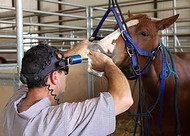Restorative Equine Dentistry
Oct 17th 2011
A trip to the dentist isn’t what it used to be. Human dentists can now easily fix nearly any problem a patient might complain about, from cavities to broken teeth. Dental care for horses isn’t quite to this point, but in recent years advancements have been made in the field of equine restorative dentistry that are giving owners options when faced with some dental disorders.
At the American Association of Equine Practitioners Focus on Dentistry meeting, held Sept. 18-20 in Albuquerque, N.M., Stephen S. Galloway, DVM, FAVD, of Animal Care Hospital in Somerville, Tenn., discussed some new restorative dentistry options for horses. Restorative dentistry aims to treat, repair, and conserve teeth broken by trauma or decay.
“Throughout recorded equine dental history, exodontia (tooth extraction) has been the primary treatment option for diseased teeth,” Galloway began. “However, the goal of dentistry is to preserve functional dentition in order to promote the general health, longevity, and productivity of the horse.
“Although equine veterinarians have practiced restorative dentistry for over 120 years, the introduction of less technique-sensitive dental materials over the last 20 years has stimulated renewed interest in direct placement restorations.”
Galloway also noted that while there are “numerous anecdotal reports” of successful restorative dental procedures, there are markedly fewer peer-reviewed studies; only a handful of case reports have been published in journals. Thus, he said, “Until the application of restorative materials in equine hypsodontic teeth (i.e., teeth that have a limited growth period, but prolonged eruption throughout the life of the animal) have been scientifically evaluated, each practitioner must make treatment decisions based on his or her personal experiences and understanding of restorative principles.”
Plan Ahead
An ideal candidate for equine restorative therapy has had his dental problem diagnosed early, Galloway said, before the tooth’s structural integrity is compromised. He noted that regardless of the reason for using restorative dentistry, the most important first step is planning the treatment. The veterinarian must prepare the cavity and decide on the restorative material and application method he or she will use before beginning the procedure, he said.
He also advocates a radiographic (X ray) evaluation of the affected tooth and surrounding area prior to beginning any dental work.
“Radiographs are critical for accurate treatment planning,” he said.
Cavity Preparation
“Cavity preparation is the surgical operation involving the debridement of decayed or diseased dental tissues in order to shape the tooth to receive and retain the restorative material,” Galloway explained.
This procedure is typically performed in a standing, sedated horse, he said, with local anesthesia being administered if the cavity extends into sensitive dental tissue. He noted three aspects a veterinarian must consider when preparing the cavity:
The cavity must be prepared so that all diseased and damaged dental tissues are removed without weakening the tooth’s structure;
The cavity is extended to prevent further decay or damage to the restoration; and
The cavity is configured to facilitate filling, retention, and finishing of the restorative material.
Restorative Material Selection and Application
“The ideal restorative material would allow for conservative cavity preparation; be easy to apply; bond to the dental tissue; have the similar strength, thermal, and wear characteristics to the tooth; and be the same color as the tooth,” Galloway noted. “No material has all of these ideal characteristics; therefore, a material or combination of materials must be selected based on its specific advantages in a specific situation.”
He described two restorative materials currently used in equine dentistry: glass ionomers (a dental cement used for numerous applications) and resin composites (types of synthetic resins, which are used in dentistry as restorative material).
“Material selection is based on the physical and mechanical properties of the materials with respect to the position of and forces applied to the cavity,” Galloway explained. “Final selection of a specific product within a given category of materials (such as a specific resin composite) is often based on the vet’s personal preference. Each category of materials typically has numerous different products.”
Post-Procedure Checks
“Long-term clinical trials to determine the performance of restorations in equine teeth are lacking, and treatment success must be determined on each patient through follow-up examinations,” Galloway noted.
He recommends the veterinarian examine the patient at three, six, and 12 months after the procedure and evaluate his radiographs annually.
Post-procedure, horses can return to their normal work and eating habits upon recovering from sedation, Galloway said.
While minor complications occasionally accompany a restorative dentistry procedure, they often involved the materials used rather than the horse’s health, Galloway relayed.
“The most common complication of direct placement restoration is ‘marginal leakage,’ which is the failure of the restoration around the margin of the cavity which could include extension of tooth decay,” he said. “If the restoration fails, it is removed and the veterinarian starts over.”
Take-Home Message
Explore the power of the human-horse connection as you travel the emotional journey that veterinarians at Rood and Riddle Equine Hospital and owners embark on when a beloved horse becomes ill in Equine ER
“The resurgence of veterinary dental care in the 1990s stimulated practitioners to investigate the tooth-preserving dental disciplines (endodontics, orthodontic, periodontics, and restorative dentistry) in horses,” Galloway concluded. “Accepted dental procedures and material applications have been extrapolated from human and small animal veterinary dentistry for use in the equine patient and anecdotal reports of success support the continuation of these practices.”
While restorative dentistry in horses appears to have a promising future, Galloway issued a word of caution: “Treatment failures and the inappropriate selection and application of dental materials demonstrates the need for scientific investigation and formal training in advanced dental procedures instead of the current widespread state of experimentation on equine patients.
“With continued case reporting by practitioners and clinical research by universities, our restorative treatment decisions in equine patients will become evidence-based.”

